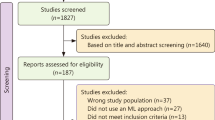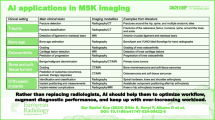Abstract
Musculoskeletal trauma accounts for a significant fraction of emergency department visits and patients seeking urgent care, with a high financial cost to society. Diagnostic imaging is indispensable in the workup and management of trauma patients. However, diagnostic imaging represents a complex multifaceted system, with many aspects of its workflow prone to inefficiencies or human error. Recent technological innovations in artificial intelligence and machine learning have shown promise to revolutionize our systems for providing medical care to patients. This review will provide a general overview of the current state of artificial intelligence and machine learning applications in different aspects of trauma imaging and provide a vision for how such applications could be leveraged to enhance our diagnostic imaging systems and optimize patient outcomes.








Similar content being viewed by others
References
Stinner DJ, Edwards D. Surgical management of musculoskeletal trauma. Surg Clin N Am. 2017. https://doi.org/10.1016/j.suc.2017.06.005.
Kim PK. Radiology for trauma and the general surgeon. Surg Clin N Am. 2017. https://doi.org/10.1016/j.suc.2017.06.014.
Bruno MA, Walker EA, Abujudeh HH. Understanding and confronting our mistakes: the epidemiology of error in radiology and strategies for error reduction. Radiographics. 2015. https://doi.org/10.1148/rg.2015150023.
Selvarajan SK, Levin DC, Parker L. The increasing use of emergency department imaging in the United States: is it appropriate? Am J Roentgenol. 2019;213(4):W180–4. https://doi.org/10.2214/AJR.19.21386.
Chetlen AL, Chan TL, Ballard DH, et al. Addressing burnout in radiologists. Acad Radiol. 2019;26(4):526–33. https://doi.org/10.1016/j.acra.2018.07.001.
Hallas P, Ellingsen T. Errors in fracture diagnoses in the emergency deparment - characteristics of patients and diurnal variation. BMC Emerg Med. 2006. https://doi.org/10.1186/1471-227X-6-4.
Lecun Y, Bengio Y, Hinton G. Deep learning. Nature. 2015. https://doi.org/10.1038/nature14539.
Suzuki K. Overview of deep learning in medical imaging. Radiol Phys Technol. 2017. https://doi.org/10.1007/s12194-017-0406-5.
Soffer S, Ben-Cohen A, Shimon O, Amitai MM, Greenspan H, Klang E. Convolutional neural networks for radiologic images: a radiologist’s guide. Radiology. 2019. https://doi.org/10.1148/radiol.2018180547.
Hirschmann A, Cyriac J, Stieltjes B, Kober T, Richiardi J, Omoumi P. Artificial intelligence in musculoskeletal imaging: review of current literature, challenges, and trends. Semin Musculoskelet Radiol. 2019. https://doi.org/10.1055/s-0039-1684024.
Chea P, Mandell JC. Current applications and future directions of deep learning in musculoskeletal radiology. Skeletal Radiol. 2020. https://doi.org/10.1007/s00256-019-03284-z.
Gorelik N, Chong J, Lin DJ. Pattern recognition in musculoskeletal imaging using artificial intelligence. Semin Musculoskelet Radiol. 2020;24(1):38–49. https://doi.org/10.1055/s-0039-3400266.
Kalmet PHS, Sanduleanu S, Primakov S, et al. Deep learning in fracture detection: a narrative review. Acta Orthop. 2020;91(2):215–20. https://doi.org/10.1080/17453674.2019.1711323.
Langerhuizen DWG, Janssen SJ, Mallee WH, et al. What are the applications and limitations of artificial intelligence for fracture detection and classification in orthopaedic trauma imaging? A systematic review. Clin Orthop Relat Res. 2019. https://doi.org/10.1097/CORR.0000000000000848.
Gyftopoulos S, Lin D, Knoll F, Doshi AM, Rodrigues TC, Recht MP. Artificial intelligence in musculoskeletal imaging: current status and future directions. Am J Roentgenol. 2019. https://doi.org/10.2214/AJR.19.21117.
Rajpurkar P, Irvin J, Bagul A, et al. MURA: Large dataset for abnormality detection in musculoskeletal radiographs. arXiv. Published online 2017.
Lindsey R, Daluiski A, Chopra S, et al. Deep neural network improves fracture detection by clinicians. Proc Natl Acad Sci U S A. 2018;115(45):11591–6. https://doi.org/10.1073/pnas.1806905115.
Krogue JD, Cheng KV, Hwang KM, et al. Automatic hip fracture identification and functional subclassification with deep learning. Radiol Artif Intell. 2020;2(2):e190023. https://doi.org/10.1148/ryai.2020190023.
Jones RM, Sharma A, Hotchkiss R, et al. Assessment of a deep-learning system for fracture detection in musculoskeletal radiographs. NPJ Digit Med. 2020;3(1):144. https://doi.org/10.1038/s41746-020-00352-w.
Langerhuizen DWG, Bulstra AEJ, Janssen SJ, et al. Is deep learning on par with human observers for detection of radiographically visible and occult fractures of the scaphoid? Clin Orthop Relat Res. 2020. https://doi.org/10.1097/CORR.0000000000001318.
Aghnia Farda N, Lai J-Y, Wang J-C, Lee P-Y, Liu J-W, Hsieh I-H. Sanders classification of calcaneal fractures in CT images with deep learning and differential data augmentation techniques. Injury. Published online September 16, 2020. https://doi.org/10.1016/j.injury.2020.09.010.
Chung SW, Han SS, Lee JW, et al. Automated detection and classification of the proximal humerus fracture by using deep learning algorithm. Acta Orthop. 2018. https://doi.org/10.1080/17453674.2018.1453714.
Krogue JD, Cheng K, Hwang KM, et al. Automatic hip fracture identification and functional subclassification with deep learning. arXiv. Published online 2019. https://doi.org/10.1148/ryai.2020190023
Tanzi L, Vezzetti E, Moreno R, Aprato A, Audisio A, Massè A. Hierarchical fracture classification of proximal femur X-ray images using a multistage deep learning approach. Eur J Radiol. 2020. https://doi.org/10.1016/j.ejrad.2020.109373.
Olczak J, Emilson F, Razavian A, Antonsson T, Stark A, Gordon M. Ankle fracture classification using deep learning: automating detailed AO Foundation/Orthopedic Trauma Association (AO/OTA) 2018 malleolar fracture identification reaches a high degree of correct classification. Acta Orthop. Published online 2020. https://doi.org/10.1080/17453674.2020.1837420
Zhou QQ, Tang W, Wang J, et al. Automatic detection and classification of rib fractures based on patients’ CT images and clinical information via convolutional neural network. Eur Radiol. 2020. https://doi.org/10.1007/s00330-020-07418-z.
Pranata YD, Wang KC, Wang JC, et al. Deep learning and SURF for automated classification and detection of calcaneus fractures in CT images. Comput Methods Prog Biomed. 2019;171:27–37. https://doi.org/10.1016/j.cmpb.2019.02.006.
Tomita N, Cheung YY, Hassanpour S. Deep neural networks for automatic detection of osteoporotic vertebral fractures on CT scans. Comput Biol Med. 2018;98:8–15. https://doi.org/10.1016/j.compbiomed.2018.05.011.
Mutasa S, Varada S, Goel A, Wong TT, Rasiej MJ. Advanced deep learning techniques applied to automated femoral neck fracture detection and classification. J Digit Imaging. 2020. https://doi.org/10.1007/s10278-020-00364-8.
Bien N, Rajpurkar P, Ball RL, et al. Deep-learning-assisted diagnosis for knee magnetic resonance imaging: development and retrospective validation of MRNet. PLoS Med. 2018. https://doi.org/10.1371/journal.pmed.1002699.
Liu F, Guan B, Zhou Z, et al. Fully automated diagnosis of anterior cruciate ligament tears on knee MR images by using deep learning. Radiol Artif Intell. 2019. https://doi.org/10.1148/ryai.2019180091.
Couteaux V, Si-Mohamed S, Nempont O, et al. Automatic knee meniscus tear detection and orientation classification with Mask-RCNN. Diagn Interv Imaging. 2019. https://doi.org/10.1016/j.diii.2019.03.002.
Roblot V, Giret Y, BouAntoun M, et al. Artificial intelligence to diagnose meniscus tears on MRI. Diagn Interv Imaging. 2019. https://doi.org/10.1016/j.diii.2019.02.007.
Liu F, Zhou Z, Samsonov A, et al. Deep learning approach for evaluating knee MR images: achieving high diagnostic performance for cartilage lesion detection. Radiology. 2018;289(1):160–9. https://doi.org/10.1148/radiol.2018172986.
Willemink MJ, Koszek WA, Hardell C, et al. Preparing medical imaging data for machine learning. Radiology. 2020. https://doi.org/10.1148/radiol.2020192224.
Oakden-Rayner L. Exploring large-scale public medical image datasets. Acad Radiol. 2020. https://doi.org/10.1016/j.acra.2019.10.006.
Badgeley MA, Zech JR, Oakden-Rayner L, et al. Deep learning predicts hip fracture using confounding patient and healthcare variables. npj Digit Med. 2019;2(1):31. https://doi.org/10.1038/s41746-019-0105-1.
Zech JR, Badgeley MA, Liu M, Costa AB, Titano JJ, Oermann EK. Variable generalization performance of a deep learning model to detect pneumonia in chest radiographs: a cross-sectional study. PLoS Med. 2018. https://doi.org/10.1371/journal.pmed.1002683.
Hendrickx LAM, Sobol GL, Langerhuizen DWG, et al. A machine learning algorithm to predict the probability of (occult) posterior malleolar fractures associated with tibial shaft fractures to guide “malleolus first” fixation. J Orthop Trauma. 2020. https://doi.org/10.1097/BOT.0000000000001663.
A machine learning algorithm to identify patients with tibial shaft fractures at risk for infection after operative treatment. J Bone Jt Surg. Published online 2020. https://doi.org/10.2106/jbjs.20.00903.
O’Neill TJ, Xi Y, Stehel E, et al. Active reprioritization of the reading worklist using artificial intelligence has a beneficial effect on the turnaround time for interpretation of head CT with intracranial hemorrhage. Radiol Artif Intell. 2021. https://doi.org/10.1148/ryai.2020200024.
Recht MP, Zbontar J, Sodickson DK, et al. Using deep learning to accelerate knee MRI at 3 T: results of an interchangeability study. Am J Roentgenol. 2020;215(6):1421–9. https://doi.org/10.2214/AJR.20.23313.
Dreizin D, Zhou Y, Fu S, et al. A multiscale deep learning method for quantitative visualization of traumatic hemoperitoneum at CT: assessment of feasibility and comparison with subjective categorical estimation. Radiol Artif Intell. 2020. https://doi.org/10.1148/ryai.2020190220.
Dreizin D, Zhou Y, Chen T, et al. Deep learning-based quantitative visualization and measurement of extraperitoneal hematoma volumes in patients with pelvic fractures: potential role in personalized forecasting and decision support. J Trauma Acute Care Surg. Published online 2020. https://doi.org/10.1097/TA.0000000000002566.
O’Connor SD, Graffy PM, Zea R, Pickhardt PJ. Does nonenhanced CT-based quantification of abdominal aortic calcification outperform the Framingham risk score in predicting cardiovascular events in asymptomatic adults? Radiology. 2019. https://doi.org/10.1148/radiol.2018180562.
Bachmann KN, Bruno AG, Bredella MA, et al. Vertebral strength and estimated fracture risk across the BMI spectrum in women. J Bone Miner Res. 2016. https://doi.org/10.1002/jbmr.2697.
Pickhardt PJ, Pooler BD, Lauder T, del Rio AM, Bruce RJ, Binkley N. Opportunistic screening for osteoporosis using abdominal computed tomography scans obtained for other indications. Ann Intern Med. 2013;158(8):588–95. https://doi.org/10.7326/0003-4819-158-8-201304160-00003.
Wang B, Torriani M. Artificial intelligence in the evaluation of body composition. Semin Musculoskelet Radiol. 2020;24(1):30–7. https://doi.org/10.1055/s-0039-3400267.
Boutin RD, Lenchik L. Value-added opportunistic CT: insights into osteoporosis and sarcopenia. Am J Roentgenol. 2020. https://doi.org/10.2214/AJR.20.22874.
Orces CH. Emergency department visits for fall-related fractures among older adults in the USA: a retrospective cross-sectional analysis of the National Electronic Injury Surveillance System All Injury Program, 2001–2008. BMJ Open. 2013. https://doi.org/10.1136/bmjopen-2012-001722.
Chen KW, Chang SF, Lin PL. Frailty as a predictor of future fracture in older adults: a systematic review and meta-analysis. Worldviews Evidence-Based Nurs. 2017;14(4):282–93. https://doi.org/10.1111/wvn.12222.
Hall DE, Arya S, Schmid KK, et al. Association of a frailty screening initiative with postoperative survival at 30, 180, and 365 days. JAMA Surg. 2017. https://doi.org/10.1001/jamasurg.2016.4219.
Castillo-Angeles M, Cooper Z, Jarman MP, Sturgeon D, Salim A, Havens JM. Association of frailty with morbidity and mortality in emergency general surgery by procedural risk level. JAMA Surg. Published online November 25, 2020. https://doi.org/10.1001/jamasurg.2020.5397.
Wang B, Torriani M. Artificial intelligence in the evaluation of body composition. Semin Musculoskelet Radiol. 2020;24:30–7. https://doi.org/10.1055/s-0039-3400267.
Bridge CP, Rosenthal M, Wright B, et al. Fully-automated analysis of body composition from CT in cancer patients using convolutional neural networks. In: Stoyanov D, Taylor Z, Sarikaya D, et al., eds. OR 2.0 context-aware operating theaters, computer assisted robotic endoscopy, clinical image-based procedures, and skin image analysis. Springer International Publishing; 2018:204–213.
Weston AD, Korfiatis P, Kline TL, et al. Automated abdominal segmentation of CT scans for body composition analysis using deep learning. Radiology. 2019;290(3):669–79. https://doi.org/10.1148/radiol.2018181432.
Kaplan SJ, Pham TN, Arbabi S, et al. Association of radiologic indicators of frailty with 1-year mortality in older trauma patients: opportunistic screening for sarcopenia and osteopenia. JAMA Surg. 2017;152(2):1–8. https://doi.org/10.1001/jamasurg.2016.4604.
Leeper CM, Lin E, Hoffman M, et al. Computed tomography abbreviated assessment of sarcopenia following trauma. J Trauma Acute Care Surg. Published online 2016. https://doi.org/10.1097/ta.0000000000000989.
Author information
Authors and Affiliations
Corresponding author
Ethics declarations
Conflict of interest
The authors declare no competing interests.
Additional information
Publisher’s note
Springer Nature remains neutral with regard to jurisdictional claims in published maps and institutional affiliations.
Rights and permissions
About this article
Cite this article
Laur, O., Wang, B. Musculoskeletal trauma and artificial intelligence: current trends and projections. Skeletal Radiol 51, 257–269 (2022). https://doi.org/10.1007/s00256-021-03824-6
Received:
Revised:
Accepted:
Published:
Issue Date:
DOI: https://doi.org/10.1007/s00256-021-03824-6




